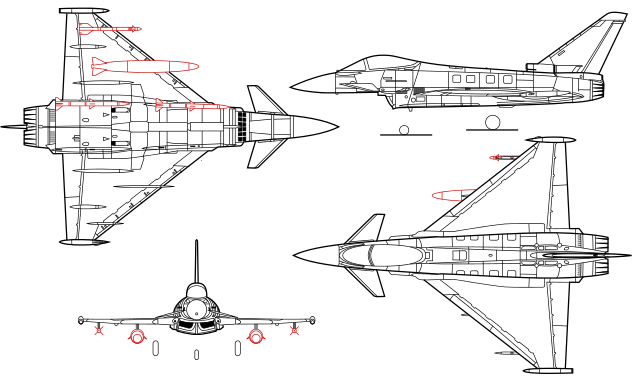The pivot wing, also called oblique wing is a type of wing design that tries to minimize the drag over the entire speed range of the aircraft.
At low speeds, the main concern is the induced drag, which can be reduced by increasing the aspect ratio. That is why low speed aircrafts like gliders have very long slender wings.
As the speed increases, the induced drag falls off quickly and the wave drag comes to dominate at supersonic speeds. This is the reason why supersonic aircrafts have highly swept wings with very small aspect ratios.
One way to reduce the drag at high speeds is to sweep the wing. The velocity component perpendicular to the wing is reduced, reducing the drag.
The delta wing is a highly swept wing used in supersonic combat aircrafts. A good example is the Eurofighter Typhoon, which is a tailless delta. The delta wing provides excellent supersonic performance and has a high stall angle. However, the wing 'bleeds' energy rapidly during turns and the requires high takeoff and landing angles.

"Eurofighter Typhoon line drawing" by Inductiveload - Own work. Licensed under Public Domain via Commons.
The trapezoidal wing is a version of high speed wing with small aspect ratio. The most famous example of the use of trapezoidal wing was the Lockheed F-104 Starfighter, which had excellent high speed performance. However, the aircraft had high takeoff and landing speeds and comparatively less low speed performance.
 "Lockheed F-104C Starfighter" by Kaboldy - Own work. Licensed under GFDL via Commons.
"Lockheed F-104C Starfighter" by Kaboldy - Own work. Licensed under GFDL via Commons.
Almost all the swept wings in use are swept towards the rear. One disadvantage of this kind of wing is the th airflow is from the root to the tip and as a consequence, the (outboard) ailerons stall before the inboard portion of wing and this results in loss of roll control in high angles of attack. This can be prevented by sweeping the wing forward. However, the bending stress in the wing root is increased due to aeroelastic twisting.

source: NASA
The issue with fixed sweep wings is that what is efficient in one regime will not be so in the other. One way to reduce the drag in all speeds is to change the sweep and aspect ratio of the wing.
The variable sweep wings change the aspect ratio by rotating a part of the wing.
 "Three F-111s with different wing configurations" by Jason B from Australia - 3 Configs. Licensed under CC BY 2.0 via Commons.
"Three F-111s with different wing configurations" by Jason B from Australia - 3 Configs. Licensed under CC BY 2.0 via Commons.
The pivot wing is an extreme version of the swept wing where the entire wing is rotated. So far, it has only been implemented in one aircraft, the NASA SD-1.
 "AD-1 ObliqueWing 60deg 19800701" by NASA - http://www1.dfrc.nasa.gov/Gallery/Photo/AD-1/HTML/ECN-15846.html. Licensed under Public Domain via Commons.
"AD-1 ObliqueWing 60deg 19800701" by NASA - http://www1.dfrc.nasa.gov/Gallery/Photo/AD-1/HTML/ECN-15846.html. Licensed under Public Domain via Commons.
The main aerodynamic advantage of the oblique wing is that by adjusting the sweep progressively, the aircrafts can be optimized for drag reduction over a wide range of Mach numbers. Also, the AD-1 was designed with elliptical wing for minimizing induced drag.
However, on the downside, as the entire wing is rotated, one side of the wing is swept forward, while the other side is swept towards the rear. This means that their stalling characteristics are entirely different. On one side (forward swept side), the inboard region stalls first, while its the opposite on the other side. This makes controlling the aircraft difficult. A follow on project of AD-1, the Northrop Grumman Switchblade was canceled over control difficulties.
The aircraft also exhibited aeroelastic and pitch-roll coupling effects that adversely affected the aircraft's handling qualities at over 45 degrees sweep.
Also, the aircraft exhibited unusual trim requirements and inertial coupling. For instance, it was reported tha the AD-1 required about 10° of bank in order to trim the aircraft with no sideslip at 60° wing sweep.
Though the pivot wing aircraft had excellent aerodynamic characteristics, its poor and unusual control characteristics prevented further development.







